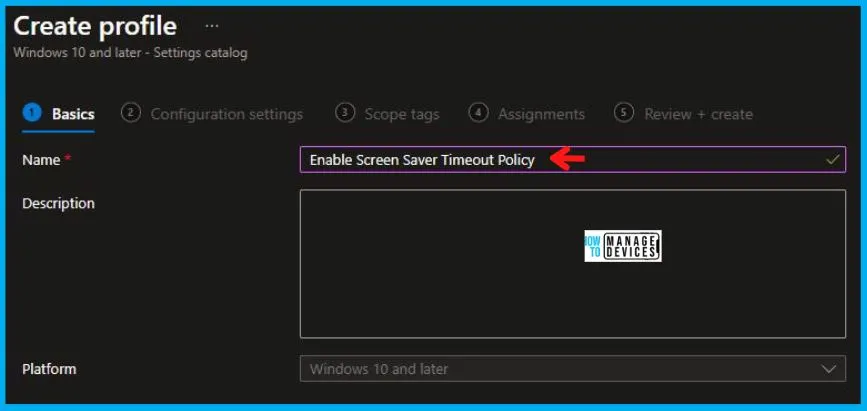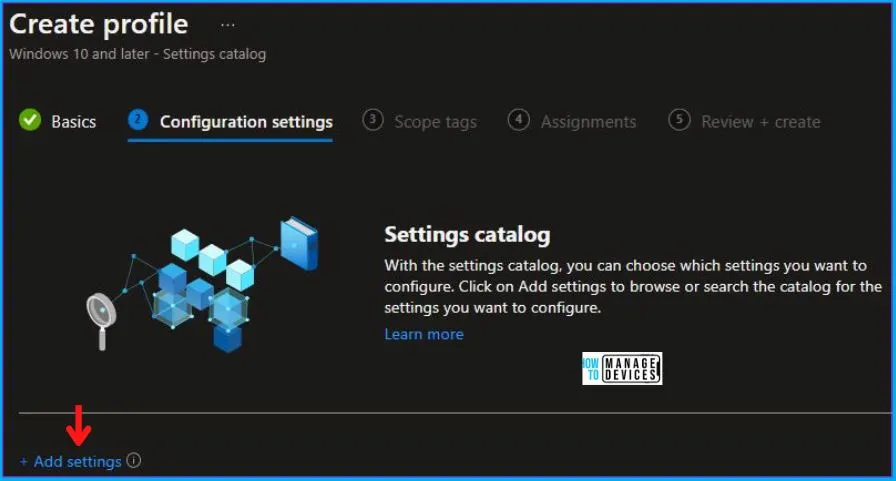This post will help you get familiar with how to Enable Screen Saver Timeout Policy using Intune. We are going to use Configuration Profiles of Intune to implement this policy. Our main purpose here is to help you acquire knowledge of how to Enable Screen Saver Timeout Policy Using Intune.
Enable Screen Saver Timeout Policy Using Intune helps in setting up the minimum time at which Screen Saver will get launched. Once adjusted, this period of idleness can range from a minimum of 1 second to a maximum of 86,400 seconds (equivalent to 24 hours). If this duration is set to zero, the screen saver will not initiate.
When left without configuration, the idle wait time established by the client through the Screen Saver dialog within the Personalization or Display Control Panel will be utilized. The default idle wait time is set to 15 minutes.
This policy helps with whether you want to Enable Screen Saver after a particular duration. There are specific conditions under which this setting does not have any impact:
- The setting is deactivated or left unconfigured.
- The idle wait time is set to zero.
- The “Enable Screen Saver” option is deactivated.
- In cases where neither the “Screen saver executable name” setting nor the Screen Saver dialog within the client computer’s Personalization or Display Control Panel indicates a valid, existing screen saver program on the client’s system.
Note! It is mandatory first to enable the Screen Saver Policy to make this policy work.

Windows CSP Details CPL_Personalization_ScreenSaverTimeOut
We will see Windows CSP Details for this Policy setting CPL_Personalization_ScreenSaverTimeOut. This feature pertains to specifying the period of user inactivity required to pass before triggering the initiation of the screen saver. Once set, this interval of idle time can be adjusted anywhere from a minimum of 1 second to a maximum of 86,400 seconds, equivalent to a full day or 24 hours. If the specified time is set to zero, it will prevent the screen saver from being activated altogether.
CSP URI – ./User/Vendor/MSFT/Policy/Config/ADMX_ControlPanelDisplay/CPL_Personalization_ScreenSaverTimeOut

Enable Screen Saver Timeout Policy using Intune
To set the Enable Screen Saver Timeout Policy Using Intune, follow the steps stated below:
- Sign in to the Intune Admin Center portal https://intune.microsoft.com/.
- Select Devices > Windows > Configuration profiles > Create a profile.
In Create Profile, I select Windows 10 and later in Platform and select Profile Type as Settings catalog. Click on the Create button.
| Platform | Profile Type |
|---|---|
| Windows 10 and later | Settings Catalog |

On the Basics tab pane, I provide a name for the policy as “Enable Screen Saver Timeout Policy.” Optionally, if you want, you can enter a policy description and proceed by selecting “Next.”

Now in Configuration Settings, click Add Settings to browse or search the catalog for the settings I want to configure.

In the Settings Picker windows, I searched for the keyword Screen Saver, I found the category Administrative Templates\Control Panel\Personalization and selected this.
When I select that option as stated above, I see one sub-category among many, Screen saver timeout (User). After selecting that, click the cross mark at the right-hand corner.

I kept the Screen saver timeout (User) as Enabled in the Administrative Templates. After enabling this, you will see another option in which you have to enter the duration at which the screen saver launched. Here I kept the duration to 900 secs (15 mins). After this, click on Next to continue.

Using Scope tags, you can assign a tag to filter the profile to specific IT groups. One can add scope tags (if required) and click Next to continue. Now in Assignments, in Included Groups, you need to click on Add Groups, choose Select Groups to include one or more groups, and click Next to continue.

In the Review + Create tab, I review settings. After clicking on Create, changes are saved, and the profile is assigned.

Upon successfully creating the “Enable Screen Saver Timeout Policy,“ notification will appear in the top right-hand corner, confirming the action. You can also verify the policy’s existence by navigating to the Configuration Profiles list, where it will be prominently displayed.
Your groups will receive your profile settings when the devices check in with the Intune service. The Policy applies to the device.
Intune Report for Enable Screen Saver Timeout Policy
From Intune Portal, you can view the Intune settings catalog profile report, which provides an overview of device configuration policies and deployment status.
To track the assignment of the policy, you need to select the relevant policy from the Configuration Profiles list. Reviewing the device and user check-in status lets you determine if the policy has been successfully applied. If you require more detailed information, you can click on “View Report” to access additional insights.

Intune MDM Event Log
To verify the successful implementation of String or integer policies on Windows 10 or 11 devices through Intune, you can leverage event IDs 813 and 814. These event IDs provide valuable insights into the application status of the policy as well as the specific value assigned to the policy on those devices. In the case of this particular policy, the value is String and is linked to the event ID 814.
By analyzing these event IDs, you can gain a clear understanding of the policy’s application status and the corresponding value associated with it on the devices in question.
To confirm this, you can check the Event log path – Applications and Services Logs – Microsoft – Windows – Devicemanagement-Enterprise-Diagnostics-Provider – Admin.
MDM PolicyManager: Set policy string, Policy: (CPL_Personalization_ScreenSaverTimeOut), Area: (ADMX_ControlPanelDsiplay), EnrollmentID requesting merge: (5B88AEF1-09E8-43BB-B144-7254ACBBDF3E), Current User: (S-1-12-13186897695-1137825691-1845872004-278613382), String: (<enabled/><data id=”ScreenSaverTimeOutFreqSpin” value=”900″ />), Enrollment Type: (0x6), Scope: (0x1).

When I opened the above Event log, I found that the policy I had applied to the device was successfully implemented. By reviewing the log entry shown in the above image, the Event Viewer, I came across essential information, including the Area and Enrollment ID. These details play a significant role in identifying the corresponding registry path. To locate the specific information, please consult the table provided below:
| Area | Policy | String | Scoped | Event ID |
|---|---|---|---|---|
| ADMX_ControlPanelDsiplay | CPL_Personalization_ScreenSaverTimeOut | Enabled | User | 814 |
The details presented in the table above for the Enable Screen Saver Timeout Policy Using Intune can be employed to access the registry settings that hold the group policy configurations on a specific computer. To accomplish this, you can execute “REGEDIT.exe” on the target computer and navigate to the precise registry path where these settings are stored.
- Computer\HKEY_LOCAL_MACHINE\SOFTWARE\Microsoft\PolicyManager\providers\5B88AEF1-09E8-43BB-B144-7254ACBBDF3E\default\S-1-12-13186897695-1137825691-1845872004-278613382\ADMX_ControlPanelDsiplay
When you navigate the above path in the Registry Editor, you will find the registry key named CPL_Personalization_ScreenSaverTimeOut. Also, when I navigated to the above path, I saw that the Registry Key was created.
| Registry Name | Value |
|---|---|
| CPL_Personalization_ScreenSaverTimeOut | Enabled |

Author
Abhinav Rana is working as an SCCM Admin. He loves to help the community by sharing his knowledge. He is a B.Tech graduate in Information Technology.

Thank you!
This was super helpful